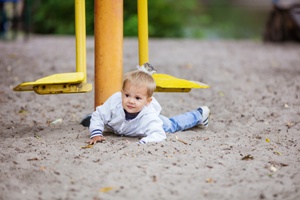What Parents Need to Know if a Child Has Been Injured on a Playground or Park in Tennessee
Playgrounds are supposed to be safe places where children can get exercise, breathe fresh air, and make new friends. However, playgrounds are one of the most common locations for children to suffer serious accidents. According to the Centers for Disease Control and Prevention (CDC), hospital emergency rooms treat more than 200,000 children under the age of fourteen each year as a result of playground-related injuries, many of which have fatal consequences.
How Children Are Hurt on Tennessee Playgrounds

The most common cause of injuries in parks and on playgrounds is a severe fall. Over 75% of injuries involve children falling from play structures, monkey bars, ladders, rock walls, steps, or other climbing equipment. Children may slip on a wet surface, lose their grip, or lose their balance, causing them to tumble to the ground and potentially strike other objects on the way down. While falls are the most common method of injury, they are by no means the only hazard for children at play. Playground accident can cause a wide variety of injuries, including:
- Brain injury. A blow to the head from a fall, swing of a bat, or fly ball can result in skull fractures, concussions, vision problems, seizures, or other complications of traumatic brain injury.
- Facial trauma. Tripping hazards such as tree roots, broken concrete, or uneven steps can cause broken noses, chipped teeth, fractured cheekbones, and other facial injuries that can cause lifelong scarring and disfigurement.
- Broken bones. A child playing on a seesaw, jungle gym, or even a swing can suddenly strike the ground hard enough to break a bone. If they fall forward, children will often fall on an outstretched arm, fracturing the bones in the hand or elbow. Falling backward can cause a broken tailbone, while rib fractures can result in internal bleeding and organ injuries.
- Entanglement injuries. Small spaces and protrusions in playground equipment are extremely dangerous, as children can easily become trapped by their hair, limbs, or whole bodies. Children often suffer injuries as they attempt to break free from gaps in chains, slide railings, ladder rungs, or between boards or slats.
- Amputation. Amputations may occur when equipment tips over or collapses, trapping children underneath the heavy metal or wooden structure. However, children may also lose fingers, toes, feet, or hands due to unprotected pinch points or bolt holes.
- Cuts and abrasions. Pointed edges, exposed metal on slides, and sharp protrusions can cause puncture wounds and lacerations that result in infection, nerve damage, scars, and extreme pain and emotional trauma.
- Strangulation. The majority of fatal injuries on playgrounds are caused by asphyxiation. Children may be hung by the neck as a result of improper use of toys (such as jump ropes), catching a hood or sweatshirt on an exposed nail, or becoming caught in a small opening that entraps the child’s head.
Who Can Be Held Liable for a Playground Accident?
There are many remedies available for children who have been injured due to someone else’s negligence. Your injury lawsuit will begin by identifying who could (and should) have prevented your child’s injury, as well as totaling the amount of damages you are owed for your child’s medical bills, rehabilitation, emotional trauma, disfigurement, future lost income, and other family losses. Several parties may be responsible for your child’s injury, particularly if the incident was caused by:
- Faulty equipment. Equipment may be considered faulty if it does not meet reasonable safety standards to prevent child injuries. For example, secondhand equipment that has not been properly inspected, structures that contain manufacturing defects, poorly maintained or visibly decaying equipment, or swing sets that were not put together according to the manufacturers’ instructions for proper installation could all be considered defective.
- Hard surfaces. Private park owners (such as community associations) have a duty to ensure the playground amenities they provide are safe for use, including the surfaces underneath the equipment. If the playground is covered in asphalt and concrete, the likelihood of fall injuries is much higher than in parks covered by wood chips, sand, or pea gravel.
- Lack of supervision. Instructors in schools and daycare centers should not leave children unsupervised during playtime and should direct children to their age-appropriate play areas. Teachers, babysitters, or anyone who sends or brings children to the playground may also be liable for failing to prevent fights and bullying or neglecting to identify hazards.
- Poor park design. Playground layouts should be carefully and thoughtfully designed to minimize injuries. Errors such as failing to put enough walking space around a moving swing or placing stationary objects near tracks or running areas increase the risk of a sudden impact.
- Landscape defects. Municipal governments may be held responsible for injuries in public parks, although there may be different lawsuit filing requirements and limitations on the amount of recovery. For example, injuries caused by exposed electrical wires, downed tree limbs, broken glass, or unattended construction equipment could form the basis of a claim against a government entity.
If your child was injured on a playground, you should speak with an attorney immediately. Our injury lawyers can gather evidence on your behalf and advise you on your next steps at no cost to you, and we do not collect any payment from you until we secure a recovery. Simply fill out the short contact form on this page to set up a free initial consultation.
|
Related Links: |

